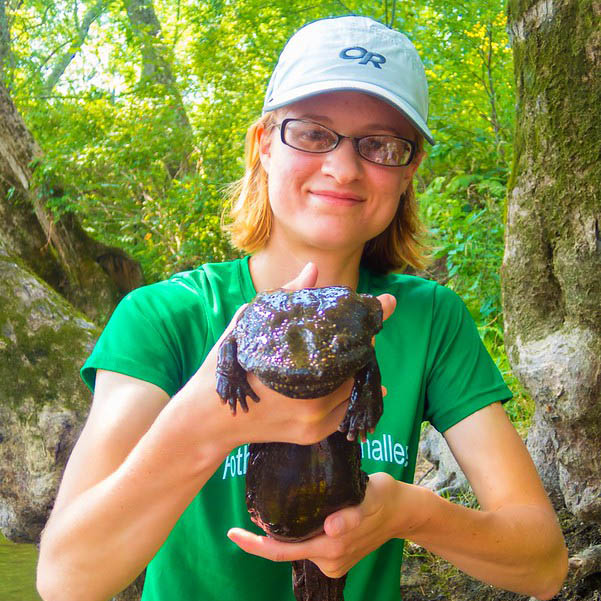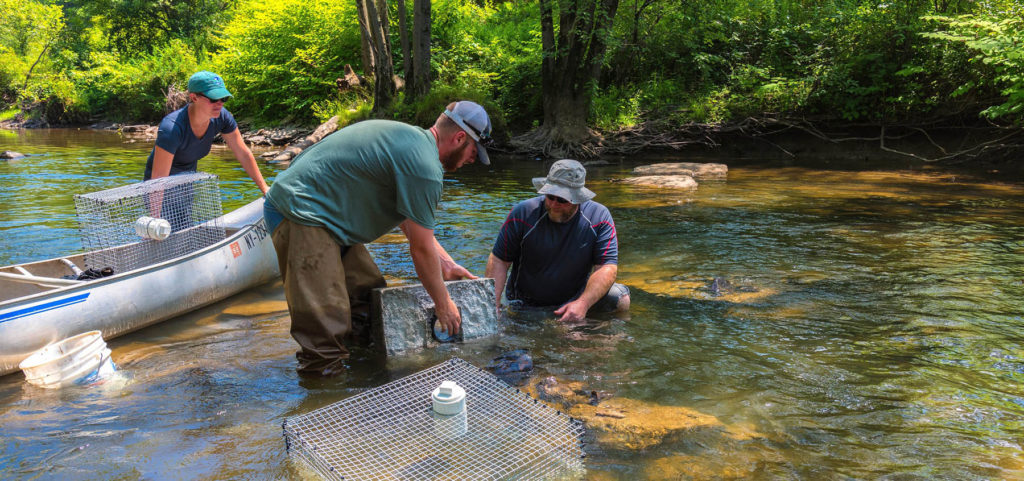Eastern Hellbender Recovery Initiative
The Eastern hellbender (Cryptobranchus alleganiensis alleganiensis) is the largest salamander in North America, reaching up to 2ft in length. They breathe through their skin and require streams and rivers with clean, fast-moving waters to provide dissolved oxygen. They can live for over 30 years in the wild, but do not typically reproduce until about 10 years old. Hellbenders are a species of Special Concern in New York State. Intensive surveying from 2013-14 produced only one individual in the entirety of their historical range along the Susquehanna River and its tributaries— one adult male guarding a nest of eggs.
From that single nest, TWT has established a program to “headstart” eggs found in the wild.
TWT is active in eastern hellbender recovery in New York’s Susquehanna River basin along three fronts: land acquisition, habitat restoration, and headstarting/reintroduction.
River and stream bottoms where hellbenders occur are typically characterized by large, flat rocks which provide cover and nesting sites. The eastern hellbender is in decline throughout its range. In New York it is restricted to small portions of the Alleghany and Susquehanna River drainages and is listed by the state of New York as a Special Concern species. Agricultural runoff, industrial pollution, dam construction, stream erosion, and disease are probable causes of the species’ decline. Maintaining good water quality is critically important for the conservation of this species. The presence of eastern hellbenders is an excellent indicator of stream health.
TWT has protected 134 acres of stream habitat and upland buffer along two Susquehanna tributaries, and we intend to acquire and protect additional critical riparian buffer lands as they become available.
Since 2016 TWT has supported cutting-edge research led by TWT biologist Michelle Herman, Dr. Peter Petokas, and Dr. James Gibbs at SUNY ESF to study headstarting eastern hellbenders and monitor their re-introduction. We have partnered with the Bronx Zoo to raise hellbenders through their larval stage. Once the juveniles are large enough, they come to TWT’s state-of-the art eastern hellbender nursery facility to be documented and PIT tagged before being released. TWT has released cohorts of robust, captive-reared juveniles in New York since 2018. As these juveniles are monitored by Michelle et al., we hope to learn more to identify potential limiting environmental/ecological factors to further reintroduction efforts both in New York and throughout their range.
Our hellbender habitat restoration efforts include installing stone slabs and concrete-fabricated ‘hellbender huts’ to enrich suitable denning and nesting habitat. Starting in 2016 we installed these hellbender huts along an approximately ½ mile stretch of stream. In 2018 and 2020 we added large, flat rocks. Following this habitat enhancement we have documented an additional 13 wild adults at the site. These adults have nested in the provided huts every year since 2017 and the population is rising.



Photo Gallery
